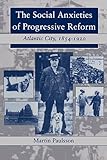The Social Anxieties of Progressive Reform : Atlantic City, 1854-1920 / Martin Paulsson.
Material type: TextSeries: The American Social Experience ; 2Publisher: New York, NY : New York University Press, [2020]Copyright date: ©1994Description: 1 online resourceContent type:
TextSeries: The American Social Experience ; 2Publisher: New York, NY : New York University Press, [2020]Copyright date: ©1994Description: 1 online resourceContent type: - 9780814766200
- 9780814768860
- 303.40974985
- online - DeGruyter
| Item type | Current library | Call number | URL | Status | Notes | Barcode | |
|---|---|---|---|---|---|---|---|
 eBook
eBook
|
Biblioteca "Angelicum" Pont. Univ. S.Tommaso d'Aquino Nuvola online | online - DeGruyter (Browse shelf(Opens below)) | Online access | Not for loan (Accesso limitato) | Accesso per gli utenti autorizzati / Access for authorized users | (dgr)9780814768860 |
Browsing Biblioteca "Angelicum" Pont. Univ. S.Tommaso d'Aquino shelves, Shelving location: Nuvola online Close shelf browser (Hides shelf browser)

|

|

|

|

|

|

|
||
| online - DeGruyter Birthmarks : Transracial Adoption in Contemporary America / | online - DeGruyter The Psychological Foundations of Evidence Law / | online - DeGruyter RePresenting Bisexualities : Subjects and Cultures of Fluid Desire / | online - DeGruyter The Social Anxieties of Progressive Reform : Atlantic City, 1854-1920 / | online - DeGruyter Criminal Justice : Nomos XXVII / | online - DeGruyter Due Process : Nomos XVIII / | online - DeGruyter Benevolent Repression : Social Control and the American Reformatory-Prison Movement / |
restricted access online access with authorization star
http://purl.org/coar/access_right/c_16ec
Tracing the evolution of Atlantic City from a miserable hamlet of fishermen's huts in 1854 to the nation's premier seaside resort in 1910, The Social Anxieties of Progressive Reform chronicles a bizarre political conflict that reaches to the very heart of Progressivism. Operating outside of the traditional constraints of family, church, and community, commercial recreation touched the rawest nerves of the reform impulse. The sight of young men and women frolicking in the surf and tangoing on the beach and the presence of unescorted women in boardwalk cafs and cabarets translated for many Progressives, secular and evangelical alike, into a wholesale rejection of socio-sexual restraints and portended disaster for the American family. While some viewed Atlantic City as a modern-day Sodom and Gomorrah, others considered the resort the triumph of American democracy and a healthy and innocent release from the drudgery and regimentation of industrial society. These conflicting currents resulted in a policy of strategic censorship that evolved in stages during the formative years of the city. Sunday drinking, gambling, and prostitution were permitted, albeit under increasingly stringent controls, but resort amusements were significantly restricted and shut down entirely on Sunday. This policy also segregated blacks from the beach and the boardwalk. By 1890, more than one in five residents of Atlantic City was black, a uniquely high ratio among northern cities. While the urban economies of the north depended on immigrant labor, the resort economy of Atlantic City rested on legions of black cooks, waiters, bellmen, and domestic workers. Paulsson's description of African-American life in Atlantic City provides a vivid and comprehensive picture of life in the North during the decades following the Civil War.Paulsson's work, and his focus on changing social values and growing racial tensions, brings to light an ongoing crisis in American society, namely the chasm between religion and mass culture as embodied by the indifference to the sanctity of the Sabbath. In Atlantic City, churches mounted a nationwide effort to preserve the Christian Sunday, a movement that grew steadily after the Civil War. Paullson's account of modern Sabbatarianism provides fresh insights into the nature of evangelical reform and its relationship to the Progressive movement. Filled with over forty delightful historical photographs that vividly depict the evolution of the resort's architecture, political scene, and even swimwear, The Social Anxieties of Progressive Reform is must reading for anyone interested in American mass culture, Progressivism, and reform movements. Paulsson has illustrated the story with over forty delightful historical photographs that vividly depict the evolution of the resort's architecture, political scene, and even swimwear.
Mode of access: Internet via World Wide Web.
In English.
Description based on online resource; title from PDF title page (publisher's Web site, viewed 01. Nov 2023)


